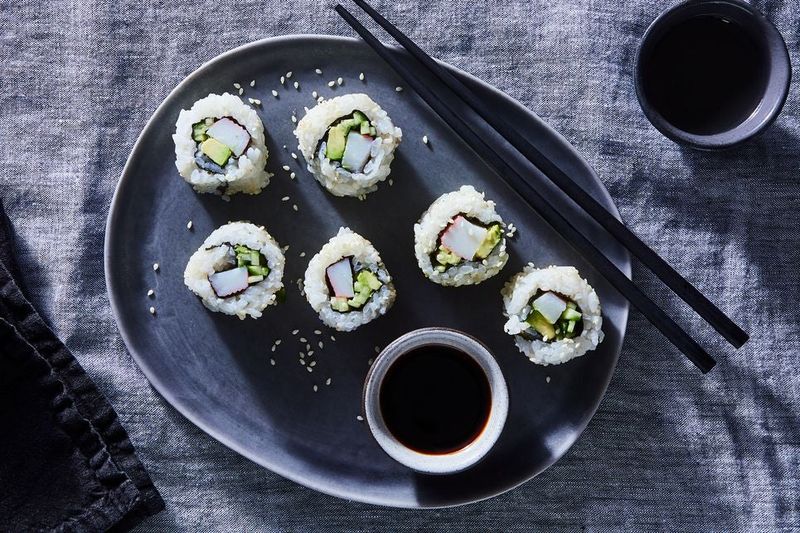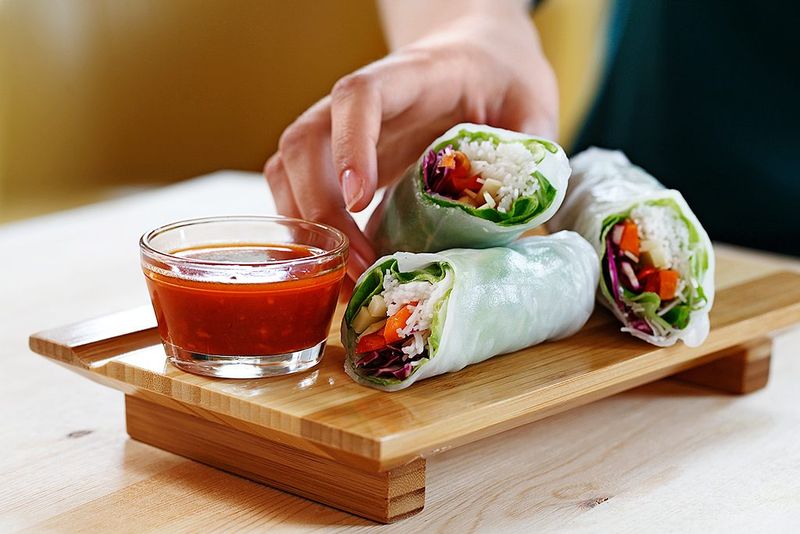15 Iconic Food Inventions That Faced Mockery Before Becoming Popular
Believe it or not, some of today’s most beloved foods were once laughed at, criticized, or straight-up rejected when they first appeared. Whether it was because they were ahead of their time, seemed too weird, or simply broke the rules of tradition, these 15 food inventions took a while to win over the public—but eventually became icons.
1. Sushi (in the U.S.)

When sushi first landed stateside in the ’60s and ’70s, many Americans cringed at the idea of eating raw fish. They couldn’t fathom how raw seafood could be both safe and delicious. Early adopters faced ridicule, yet they persisted.
Over time, sushi chefs creatively adapted the cuisine, introducing more familiar flavors and forms like California rolls. This helped to ease apprehensions. Eventually, sushi became a staple on menus everywhere. Its transformation from a misunderstood delicacy to a beloved dining choice is astounding. Sushi’s rise demonstrates how cultural exchanges can enrich our culinary landscape.
2. The Microwave Oven

Originally called “Radarange,” early microwaves were bulky, expensive, and mistrusted by the public. Some feared the radiation might be harmful, while others doubted its cooking ability. It seemed too futuristic.
Despite initial skepticism, the convenience of quick cooking couldn’t be ignored. The microwave revolutionized home cooking, allowing for faster meal preparation. As prices dropped and designs became sleeker, it found its way into homes worldwide. The microwave’s journey from a curiosity to an essential kitchen appliance highlights the shifting tides of technological acceptance.
3. Avocado Toast

Avocado toast was once dismissed as millennial nonsense or “hipster food.” Critics saw it as overpriced and trivial, mocking its popularity as a fad. However, its simple, nutritious appeal gradually won over skeptics.
The smashed green snack is now a brunch menu standard across the globe. Its combination of creamy avocado, crunchy bread, and diverse toppings offers a versatile platform for creativity. What started as a niche trend blossomed into a beloved dish, celebrated for its fresh, wholesome flavors. Avocado toast exemplifies how culinary trends can shift perceptions over time.
4. The Cronut

The cronut, a croissant-donut mashup, was mocked as a gimmick when it debuted. Pastry purists scoffed at the idea, dismissing it as a fleeting trend. Yet, its unique texture and flavor captivated dessert lovers.
Now, the cronut is a global pastry sensation. Long lines and loyal fans attest to its enduring popularity. Its creation sparked a wave of hybrid treats, merging culinary traditions in exciting ways. The cronut’s journey from novelty to icon illustrates the power of innovation in the food world.
5. Greek Yogurt

People weren’t used to its thick, tangy texture. When Greek yogurt first appeared, critics called it “sour” and unappealing. Traditional yogurt lovers couldn’t understand its allure.
However, its high protein content and creamy richness quickly won converts. Greek yogurt overtook traditional yogurt in the U.S., celebrated for its health benefits and taste. It became a breakfast staple and a versatile ingredient in cooking and baking. Greek yogurt’s rise demonstrates how taste and health trends can align to create new food favorites.
6. Ranch Dressing

Initially ridiculed as a “weird buttermilk sauce,” ranch dressing faced skepticism when it was first introduced. The idea of a creamy, tangy dressing was unfamiliar to many.
Yet, its versatility and savory flavor quickly won fans. Ranch became the most popular salad dressing in America. Beyond salads, it evolved into a universal dip for everything from pizza to wings. Ranch dressing’s transformation from oddity to staple underscores the appeal of bold, adaptable flavors in American cuisine.
7. Brussels Sprouts

Once the ultimate childhood “yuck” vegetable, Brussels sprouts faced an uphill battle. Boiled and bland, they were notorious for their unpleasant smell and taste.
However, new roasting techniques and creative preparations have turned Brussels sprouts into a trendy, craveable side dish. Chefs embraced their nutty flavor and crispy texture, transforming them into a culinary darling. The resurrection of Brussels sprouts exemplifies how innovative cooking methods can change public perception and elevate a humble vegetable to new heights.
8. Vegan Burgers (Beyond & Impossible)

At first, meat-lovers scoffed at the idea of plant-based burgers that “bleed.” The notion seemed improbable and unappealing. Yet, the desire for sustainable, ethical eating fueled curiosity.
Today, brands like Beyond and Impossible have redefined the burger experience. These meat alternatives are now found in fast-food chains and grocery stores nationwide. Their success highlights an evolving food landscape, where innovation meets consumer demand for change. Vegan burgers’ rise to prominence showcases the potential for plant-based foods to challenge traditional norms.
9. Pineapple on Pizza

The sweet-and-savory combo of pineapple on pizza has sparked years of debate. Initially mocked as an abomination, the concept defied pizza tradition.
Despite detractors, Hawaiian pizza earned a permanent spot on menus. Its unique flavor profile captivates some and repels others, making it a polarizing but enduring choice. The debate surrounding pineapple on pizza continues, reflecting diverse tastes and the playful side of culinary experimentation.
10. Instant Ramen

Originally seen as a cheap, low-quality college meal, instant ramen had a reputation for being uninspired. But foodies and chefs saw potential.
With gourmet upgrades, ramen entered the world of fine dining. Upscale ramen shops now craft elaborate dishes with rich broths and premium ingredients. Instant ramen’s transformation underscores the endless possibilities of reimagining simple foods, creating something extraordinary from the ordinary.
11. Ketchup

When ketchup first appeared in America, it was dismissed as “fish sauce gone wrong.” Its origins trace back to fermented fish, puzzling many.
However, ketchup’s sweet, tangy flavor quickly gained favor. It became an essential condiment for burgers and fries, embodying Americana. Ketchup’s journey from misunderstood sauce to kitchen staple highlights how flavors can transcend their origins and become beloved worldwide.
12. Tofu

Mocked as bland or “health nut food,” tofu faced an uphill struggle for acceptance. It seemed uninspiring and lacked flavor.
Yet, its versatility and ability to absorb flavors transformed tofu into a protein star. It now features in countless global cuisines and modern recipes. Tofu’s rise demonstrates how an open mind and culinary creativity can redefine perceptions of so-called “bland” ingredients.
13. Oat Milk

Plant-based milks faced plenty of skepticism—but oat milk in particular was once laughed off. It seemed like an unnecessary alternative.
Now, oat milk is outselling almond milk in some coffee shops. Its creamy texture and neutral taste make it a favorite among baristas and consumers alike. Oat milk’s popularity surge illustrates the growing demand for sustainable, plant-based options in modern diets.
14. Sriracha Sauce

Sriracha sauce sat quietly on ethnic restaurant tables for years before exploding into mainstream shelves. Its spicy, garlicky punch captured imaginations.
Now a cult-favorite condiment, Sriracha is drizzled over everything from eggs to noodles. Its rise to fame is a testament to the power of bold flavors and the cultural exchange that defines our dining experiences.
15. The Bagel

When bagels arrived in America, they were considered “ethnic food” for Jewish immigrants. Some doubted their appeal beyond the immigrant community.
Bagels have since become a breakfast staple, embraced for their chewy texture and versatile toppings. From cream cheese to smoked salmon, bagels offer endless possibilities. Their journey from niche food to national favorite reflects the broader acceptance and celebration of diverse culinary influences.
